The best cheese in the world undoubtedly comes from Europe where
artisans and big producers endeavour to create the finest dairy products.
Cheese producing countries that come to mind are traditionally EU member states
with France leading the way in both local consumption and international
exposure. The choice of types of European cheese is staggering with every taste
catered for from rich and creamy soft cheese served simply with good bread to
tart hard cheese grated over your favourite pasta dish.
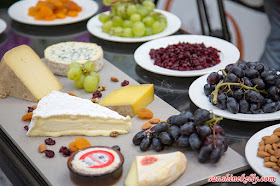 |
Cheese & Tea Pairing: A Smorgasboard of European Cheese
|
Cheese making is an ancient artisanal process and legend has it
that it was made by accident by an Arabian merchant who put milk into a sheep’s
stomach pouch and went across the desert. That night he discovered that the
milk had separated into curd (solid) and whey (liquid) caused by the rennet
(enzymes found in the stomachs of milk-fed animals) in the sheep’s stomach and
the heat of the day.
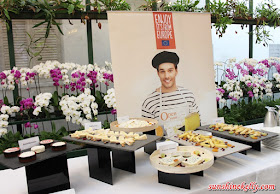 |
| A Smorgasboard of European Cheese |
Europe may now be the centre of the cheese making industry but it
is thought that travellers from Asia introduced the process. The mighty Roman
Empire was also responsible for the spread of cheese making throughout its
territories; and during the Middle Ages European monasteries experimented and
began producing different types of cheese. There are records of Gorgonzola
being made in Northern Italy in 879AD and Roquefort in France in 1070AD.
With this illustrious past, Europe is still the epicentre of the
cheese industry with their local populations consuming the majority of their
products; although it is interesting to note that emerging markets like
Malaysia’s consumption is increasing steadily as consumers become more
knowledgeable and adventurous with their palate.
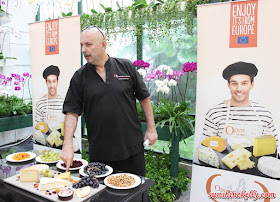 |
| Chef Jean-Michel Fraisse introduced the European Cheese
at The Majestic Hotel |
Cheese is divided into 4 types:
Soft: Ripened from the outside in with a white rind, often runny
at room temperature. Examples: Brie, Camembert, Reblochon, Mont d’Or.
Semi-soft: Smooth or creamy interior with little or no rind. Flavour
ranges from mild to pungent. Examples: Raclette, Abondance, Morbier, Port Salut.
Hard: Firm texture with tastes ranging from mild to pungent; easy
to grate. Examples: Emmental, Beaufort, Mimolette, Tomme de Savoie.
Blue: Green or blue veining caused by the addition of the mould
penicillium roqueforti during production. Examples: Saint Agur, Bleu de
Auvergne, Bleu de Gex.
European Cheese & Tea Pairing @ Orchid Room, Majestic Hotel,
KL
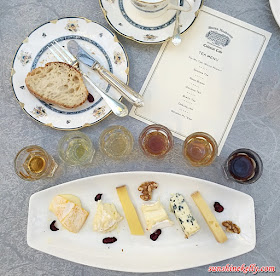 |
| Six diverse types of cheese paired with 6 different teas |
Let’s start! The Cheese Platter is a simple yet classic way to
present and enjoy different types of European cheese. Recently, the Orchid
Conservatory at the Majestic Hotel played host to an exciting Cheese Platter
experience with Chef Jean-Michel Fraisse who introduced a variety of delicious
European cheese with a unique twist – pairing the cheese with different types
of teas.
“European cheese is usually paired with certain condiments and
wines, but to show how inspired and distinctive cheese can be as an ingredient,
we have decided to use tea to enliven the tasting experience,’ said Chef
Jean-Michel. This prestigious event was part of the Open Your Taste with European
Cheese campaign organized and presented by the European Union and the CNIEL (Centre National Interprofessionel de l’Economie Laitière, France).
Chef Jean-Michel's cheese platter comprised the following types of
cheese - Saint Marcelin, Reblochon, Comté, Fourme d’Amber, Brie and Bethmale -
paired with a selection of teas.
 |
Fourme d’Ambert is a mild blue cheese with a creamy and fruity flavour
|
Fourme d’Amber: blue cheese from the Auvergene region in France made
with cow’s milk and aged for 2 months. This is one of the mildest blue cheeses
with a creamy, fruity flavour. It’s ideal for salads or eaten simply with pear
slices.
Saint Marcelin: soft cheese from Rhone Alpes region in France made
from cow’s milk and aged for 2 to 6 weeks. This is a full-flavoured creamy
cheese has a nutty and fruity taste. It’s usually served with French bread.
Reblochon: soft cheese from Rhone Alpes region in France made from
cow’s milk and aged for 6 to 8 weeks. This is exceptional creamy cheese has a strong
aroma and a nutty after taste. It’s usually melted over a potato based dish.
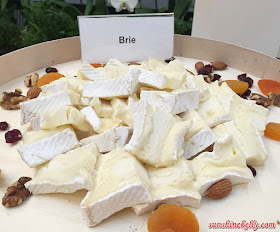 |
Brie isone of France’s most well-known cheese and a popular choice
for a cheese platter
|
Brie: one of the most well-known of France’s cheeses made from cow’s
milk and aged for at least 4 weeks with a soft creamy texture, rich aroma and mellow
flavour. Brie is popular, easily obtainable choice for a cheese platter.
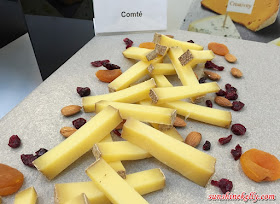 |
Comté a hard cheese with a complex fruity and nutty taste
|
Comté: hard cheese from Franche-Comté region in France made from
cow’s milk and aged for at least 4 months but can go up to 6, 12 or even 18
months. It has small scattered holes called ‘eyes’ and a complex flavour with
fruity and nutty hints. It can be eaten on its own, melted in fondue or grated
over dishes.
 |
| Bethmale semi-soft cheese that has a pungent aroma and a rich milky flavour |
Bethmale: semi-soft cheese from Pyrenees region in France made
from cow’s milk in the village of Bethmale. This cheese is aged for a minimum
of between 4 and 8 weeks. It is regularly washed with a brine solution to
encourage the growth of a mould which helps to develop the cheese. It has a
pungent aroma and a rich milky flavour.
Cheese & Tea Pairing
The selection of cheese will be paired with Pun Mun Tan (White
Peony), Sencha (Green Tea), Rose Blend, Oolong, Darjeling, Golden Pu’Erh and
Black Tea.
Fourme d’Amber pair with Darjeling
Saint Marcelin pair with Sencha or Rose Blend
Reblochon pair with Pai Mun Tan (White Peony)
Brie pair with Black Tea
Comté pair with Oolong Tea
Bethmale pair
with Golden Pu’Erh
The Majestic culinary team also offered a special cheese-based
menu to showcase the versatility of cheese as an ingredient. This was an
epicurean experience for all the senses with blind taste tests, the chance to
see how a unique cheese platter was created and most importantly to eat well. European cheeses are readily available from premium grocers and
supermarkets.

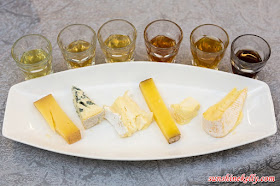
So cheesie! Majestic hotel always know how to host event. It look so majestic.
ReplyDeleteOh! I wish I could dine in Majestic Hotel.. That hotel looks os nice!!!~
ReplyDeleteOMG just can't resist CHEESE! Can I try all 4 types of cheese? Drooool :P
ReplyDeleteI like Bethmale semi-soft cheese
ReplyDeleteGosh those are way too tempting, can't deny the cheese attracts me a little ;p
ReplyDeleteSo many different types of cheese. I know I can't stomach all of them, only the milder ones.
ReplyDelete